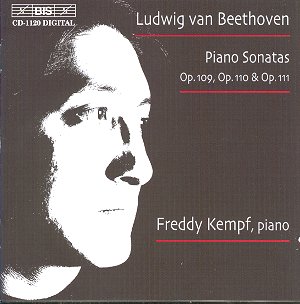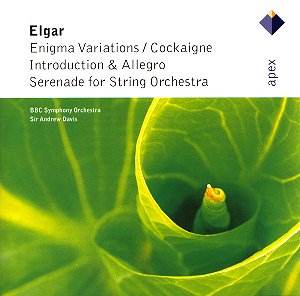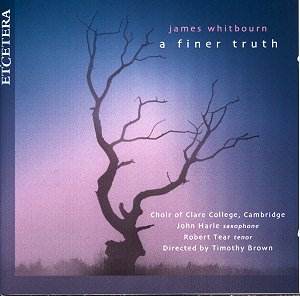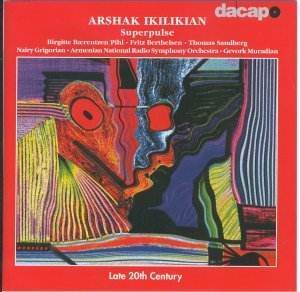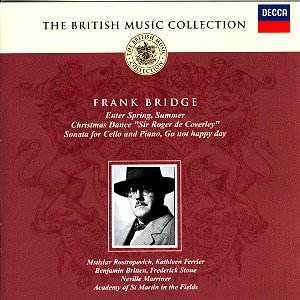 Composer: Frank Bridge
Composer: Frank Bridge
Works: Enter Spring, Summer, Christmas Dance – Sir Roger de Coverley, Sonata for Cello and Piano, Go Not Happy Day
Performers: Academy of St Martins in the Fields, Mstislav Rostropovich (cello), Benjamin Britten (piano), Kathleen Ferrier (contralto), Frederick Stone (piano)
Recording: Various recordings from 1996, 1968, and 1952
Label: DECCA
Frank Bridge, a pivotal figure in early 20th-century British music, occupies a unique position as a bridge (no pun intended) between the late Romanticism of composers like Elgar and the modernist impulses that would later characterize British music. This compilation, featuring a selection of Bridge’s works, captures the essence of his stylistic evolution from the lush harmonies of his middle period to the more austere yet expressive landscapes of his later compositions. The juxtaposition of “Enter Spring,” “Summer,” and “Go Not Happy Day” alongside the Cello Sonata offers a compelling insight into Bridge’s artistic arc and his profound impact on his contemporaries, most notably his pupil, Benjamin Britten.
“Enter Spring,” the first piece on the album, is a vibrant tone poem that bursts forth with an exuberance that is almost palpable. The orchestral palette employed by the Academy of St Martins in the Fields under Sir Neville Marriner illustrates the awakening of nature with vivid orchestration, where the brass and woodwinds interlace to evoke the sounds of jubilant birds and bustling life. Marriner’s interpretation shines in the way he balances the work’s contrasting moods—its energetic outer sections and the serene central passage are deftly handled, albeit perhaps lacking the interpretative depth found in Sir Charles Groves’s previous recording. The climaxes are thrilling, yet it is the delicate interplay of strings and woodwinds in the quieter moments that lends this performance its charm.
In contrast, “Summer” appears at first glance to be a more straightforward pastoral depiction, yet it is laced with an undercurrent of tension that Marriner captures effectively. There is a notable restlessness in the thematic development, suggesting that the idyllic summer days are not without their complexities. The rich textures and nuanced dynamics reveal a composer deeply attuned to the subtleties of nature and human emotion. The performance’s highlight is the climactic passage, where Marriner skillfully builds tension before releasing it into a resplendent conclusion, a moment that showcases both the orchestra’s technical prowess and Bridge’s sophisticated musical language.
“Christmas Dance – Sir Roger de Coverley” serves as a delightful interlude, showcasing Bridge’s ability to transform folk elements into sophisticated orchestral textures. This miniature not only captures the festive spirit of the season but also reflects Bridge’s keen craftsmanship—each string section dances with a buoyancy that is infectious. The arrangement is a testament to Bridge’s understanding of folk traditions, and the performance here is lively and engaging, making it an excellent contrast to the more introspective pieces.
The Cello Sonata, performed by the legendary duo of Rostropovich and Britten, stands as a monumental testament to Bridge’s late style. This work is marked by an emotional depth and complexity that mirrors the tumultuous period in which it was composed. The yearning melodies, influenced by the likes of Rachmaninov, are rendered with a palpable intensity by Rostropovich, whose expressive phrasing brings out the sonata’s intrinsic struggle and solace. Britten’s accompaniment is both supportive and assertive, revealing the intricate interplay between the cello and piano, a hallmark of their collaborative synergy. The recording quality from 1968 is lush and immediate, capturing the breadth of the sonority while allowing for the intimate nuances to shine through.
The album closes with Kathleen Ferrier’s rendition of “Go Not Happy Day,” a piece that encapsulates the poignant beauty of Bridge’s lyricism. Her voice, rich and hauntingly expressive, is perfectly complemented by Stone’s delicate piano accompaniment, creating an atmosphere of contemplative serenity that lingers long after the final note.
This compilation is a worthy representation of Frank Bridge’s artistic legacy, showcasing a composer who deftly navigated the transition from late Romanticism to a modern sensibility. Each performance, particularly the Cello Sonata, reflects a profound understanding of Bridge’s music, revealing layers of emotional complexity that invite listeners to explore further. The engineering quality of the recordings ensures that the subtleties and dynamics of these works are preserved, allowing both seasoned aficionados and new listeners alike to appreciate the depth of Bridge’s contribution to the British musical landscape. Highly recommended for those seeking to delve into the rich tapestry of early 20th-century British music.
